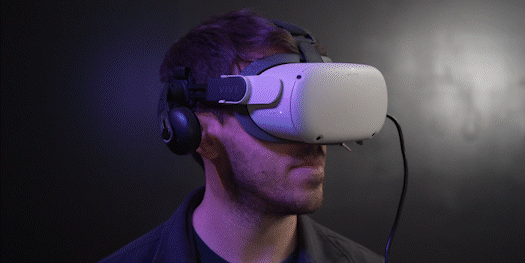If the UX field saw anything in 2023 with all its technological developments, it’s that the proverb “Let go or be dragged” holds weight moving forward. As our field progresses, we’ll be expected to put our skepticism aside and embrace changes with curiosity.

In the ever-evolving realm of UX, information architecture is instrumental in shaping users’ digital interactions. And as technology advances, staying current with the latest IA trends is important for designers, developers, and businesses — constant data bombardment impacts both businesses and individuals.
This blog post is your guide to the latest trends in information architecture. It explores how I organize and interact with data in new and exciting ways, and the trends moving other UX specialists in the same direction.
Information architecture is the art and science of structuring and presenting various elements within a system — be it a website, mobile app, blog post, book, or physical store — in a manner that facilitates easy comprehension for users.
In crafting an effective IA, two primary considerations come to the forefront: the user’s context and their needs.
Context refers to the environment in which users engage with content. It encompasses factors such as where, when, why, and how they seek and interact with the information. To ensure content makes sense to users, it’s crucial to structure it based on their needs, goals, behaviors, and expectations.
Identifying these aspects requires an understanding of the user’s identity (who they are). It also requires understanding the value they derive from the content and how they engage with it.
Information architects skillfully weave contrasting information into seamlessly navigable digital products and systems. They do this for applications, ecommerce platforms, and even the metaverse to cater to user needs. This is an integral facet of user interface and user experience design.
The future potential of IA use cases holds promise. It’s as captivating as the concurrent development of emerging technologies, content, and information systems.
As I explore these trends, we’ll uncover how IA is evolving to meet the challenges and opportunities posed by the ever-changing digital landscape.
In today’s landscape, the intersection of IA with AI is transformative. It alters how we conceive, deliver, and process information.
AI and its subset, machine learning, introduce a major paradigm shift. They enable systems to learn from data. These systems identify patterns and generate insights and recommendations. In other words, they’ll transform how we think about information architecture because they’re capable of arranging this information alongside us.
AI-driven IA systems, such as recommendation engines and personalized content delivery, showcase the power of machine learning. They understand user preferences and predict their needs.
AI-driven recommendation engines stand as prime examples of personalized user experiences within IA.
Platforms like Netflix and Amazon Prime use sophisticated algorithms to analyze viewing history, user ratings, and viewing habits. They offer tailored content suggestions.
These systems continuously adapt. They learn from user interactions to refine and enhance the personalized recommendations they provide.
In the realm of ecommerce, AI-driven IA systems revolutionize how products are presented to users:
Online retail giants, like Amazon, eBay, and Alibaba, use machine learning to understand individual shopping behaviors.
This allows them to display personalized product recommendations. It creates a highly tailored and engaging shopping experience for each user.
As we navigate the era of AI-optimized IA, a crucial consideration is striking a harmonious balance between automation and human-centered design. AI brings efficiency and predictive capabilities. However, it is imperative to uphold principles of transparency, trust, and ethics.
You have to address ethical concerns such as bias, privacy, and the explanation of AI logic and information sources to foster user confidence.
This requires thoughtfully integrating AI into IA. It should enhance user experience and uphold ethical standards. After all, trust is essential in good branding.
Many people believe AR and VR are “billion-dollar ghost towns.” This skepticism deserves reconsideration. Contrary to this perception, these technologies offer concrete value. They have moved beyond mere speculation.
With companies like Apple and Meta placing heavy bets on AR/VR, it’s likely more will businesses follow. And though humans have a bias against change, we’ve seen that it sweeps us off our feet if we aren’t prepared.
Numerous case studies demonstrate successful AR and VR integration into IA. Notably, they are used in sectors like retail, education, and healthcare.
AR and VR have found practical applications in the retail landscape. They have revolutionized the way consumers engage with products.
Imagine trying on virtual clothing and virtual glasses frames. Then, visualize furniture in your living room before making a purchase. Some examples of these are Wanna, Eyeconic, Rooomy, Homestyler:
This immersive shopping experience enhances user engagement and assists in informed decision-making. All of this requires very intricately designed information architecture to work seamlessly. It’ll be our job to envision this architecture, so we’d best start playing around with these practical applications now.
In the educational sphere, AR and VR are transforming traditional learning methods. Students can explore historical events. They can dissect complex biological structures. They can even conduct virtual science experiments.
This immersive approach not only captivates learners but also fosters deeper understanding through interactive experiences. If you’re working in education or plan on it, expect more companies to pursue these interactive experiences for visual learners.
Healthcare has adopted AR and VR to create therapeutic and educational environments, from virtual surgeries for training purposes to using AR/VR to study the human body. These technologies enrich patient care and medical education. They are used in immersive therapy sessions for mental health:
AR and VR change how users interact with information in digital spaces; it’s an entire reframing of information for those of us who have been working on desktop and mobile. The spatial, contextual, and adaptive nature of these technologies requires us to rethink IA principles.
As AR transitions into VR and further evolves into the all-encompassing metaverse, IA architects play a pivotal role in organizing and navigating these expansive digital environments.
The challenge lies in structuring information for fundamentally different interactions. How do we conceptualize discarding a file? What about sending a message? Do we use gestures? Or do we tap a 2D interface like we would on a mobile device?
Our challenge also involves avoiding cognitive overload and optimizing navigation and search systems. How do you travel through space? Do you walk or teleport or does space move around you?
AR and VR introduce new dimensions to user interaction. We need our information architecture to include user location, orientation, and actions.
We IA professionals are at the forefront of designing experiences that seamlessly blend the physical and digital worlds. Think passthrough on the Quest, which allows you to see the environment around you with the device’s interface overlaid:

The narrative of AR and VR as billion-dollar ghost towns oversimplifies their potential impact. These technologies are not empty investments. They are vibrant landscapes reshaping industries and user experiences.
By exploring their practical applications in retail, education, and healthcare, it becomes evident that AR and VR are dynamic tools. They contribute substantively to the evolution of information architecture and immersive digital experiences. Who knows? In a decade, AR and VR could be the de facto experiences we design for. But even today, they’re more and more common.
The market size of voice recognition is supposed to nearly quadruple by 2026. Despite initial skepticism about labeling voice interfaces as a niche, their trajectory is far from limited. The digital landscape experienced a significant surge in the prominence of voice and conversational interfaces. This is exemplified by smart speakers, chatbots, and voice assistants:
Once perceived as a specialized corner, it is now seamlessly integrating into everyday devices and applications. The evolution is evident in many instances. For example, interacting with smart speakers using natural language commands.
This challenges the notion of voice interfaces as a niche. It showcases their growing prevalence and integration into mainstream technologies.
Voice technology is unmistakably ubiquitous. It’s summarized by the trend towards “zero UI,” where interfaces become almost imperceptible. The seamless integration with technology, devoid of screens, is exemplified by a voice command like, “Hey, Siri.”
Amazon’s Conversation Mode further pushes boundaries, allowing for continuous dialogue without the need for wake words.
Zero UI extends beyond voice commands to include movements, gestures, and glances. This has profound implications for information architecture. Adapting search systems to diverse inputs, like visual and acoustic cues, marks a transformative phase in the realm of AI.
Voice technology’s ascent extends beyond convenience. The accessibility factor is paramount.Voice tech provides a hands-free interaction style that caters to a diverse user base.
Adapting search systems to accommodate voice commands and visual cues, gestures, and other inputs reflects the evolving landscape of IA. Perhaps in 2024, we’ll see more site search and app search that allow for voice recognition.
The need for inclusive and accessible design is more important than ever. IA professionals recognize the significance of embracing diversity and ensuring accessibility. It’s not just a design choice but a foundational principle. 2024 will see more emphasis on this; the number of digital interface users perpetually grows.
In the realm of IA, inclusivity, and accessibility stand as paramount considerations. The metaverse, voice interfaces, and the integration of AR and VR demonstrate the expanding diversity of digital experiences.
Inclusive design caters to a broader user base. It also acknowledges the diverse needs of individuals, including those with disabilities. In this environment, everyone, regardless of their abilities or background, can seamlessly engage with information.
Adhering to accessibility guidelines, IA professionals employ specific strategies like incorporating clear headings, alternative image text, and logical content organization.
These measures exemplify IA’s commitment to accommodating diverse user needs. They particularly aim to assist those with disabilities.
Innovative approaches, such as voice interfaces and metaverse organization with inclusivity in mind, further enhance accessibility.
IA emerges not just as a design tool but as a powerful instrument for promoting digital equality and accessibility. Case studies abound, illustrating how IA principles enhance user experiences for individuals with disabilities.
The metaverse, when structured with inclusivity in mind, becomes a space where everyone can navigate seamlessly. It breaks down barriers and ensures that the digital realm is accessible to all. The issue is that these fields lack resources, and without the help of information architects, they won’t build a foundation on accessibility.
IA continuously shapes the way users interact with the digital realm. As technology advances relentlessly. This journey has unveiled the transformative role of evolving trends in IA.
As I stand at the intersection of these transformative trends, the future of IA appears promising and captivating. It is not merely a tool for organizing information but a dynamic force that shapes the very fabric of user experiences.
The call to action for IA professionals is clear. Embrace these changes. Innovate in your practice. The journey as a UX designer is never-ending. IA is poised to become even more central in creating user-centered digital landscapes when we have exciting opportunities to build foundational architecture.
LogRocket's Galileo AI watches sessions and understands user feedback for you, automating the most time-intensive parts of your job and giving you more time to focus on great design.
See how design choices, interactions, and issues affect your users — get a demo of LogRocket today.

Small actions can have large consequences in complex systems. Here’s how UX designers can manage dependencies so users feel informed and in control rather than blocked or blindsided.

This article examines when hero sections are necessary in digital products, when they create friction, and how to evaluate them using UX goals, primary actions, user flow impact, and real-world alternatives.

AI speeds up tasks like research synthesis, ideation, and first-draft wireframes, but it can’t replace clarity, taste, or decision-making. Here’s a grounded look at what AI actually does well in UX right now.

Discover how to craft UX-friendly hero sections with examples, design tips, and strategies that drive engagement and conversion.